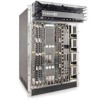Dell Force10 E600i E600 TeraScale Installation Guide - Page 61
Alarms
 |
View all Dell Force10 E600i manuals
Add to My Manuals
Save this manual to your list of manuals |
Page 61 highlights
B Alarms The E600i generates major and minor alarms for the following conditions: • fan tray status • power supply status • RPMs status • high temperature on RPMs • line cards status • high temperature on line cards • SFMs status • high temperature on SFMs. A major alarm is any fault that may render the E600i non-functional. A minor alarm is any fault that threatens the operation of the E600i. You can monitor alarm conditions on the E600i system through the console, LEDs, and audible alarms. If you configure the SNMP command (snmp-server enable traps envmon), the FTOS also sends an SNMP trap. In the E600i system, alarms are logged for each occurrence, but the system may not send an event log for multiple occurrences. For example, whenever a module exceeds the shutdown threshold, the module shuts down. If more than one module exceeds the warning or high temperature thresholds within a five minute period, the system generates one event for all effected modules, but alarms are logged for each occurrence. If the modules temperature falls to 5° lower than the warning threshold temperature, the system clears the alarm and an SNMP trap. Table B-1. Alarm Events and Reporting Module Fan tray AC Power Supplies Alarm Event Alarm LED More than one fan within the module fails major (red) or hardware failure in the module One fan within the module fails minor (amber) Hardware failure in a non-redundant power major (red) configuration (3 power supplies) Hardware failure in a redundant power configuration (4 power supplies) minor (amber) Reported in event log major minor major minor Status LED on Module amber Audible Alarm? yes amber no red or unlit yes red or unlit no Alarms | 61















